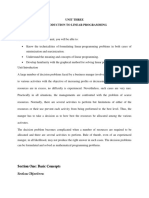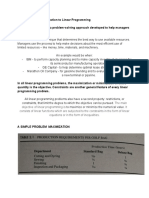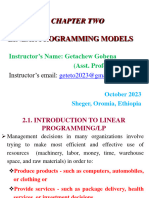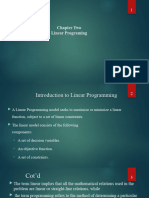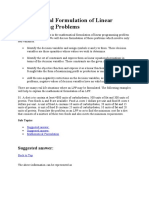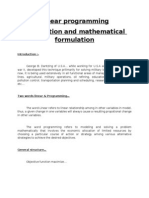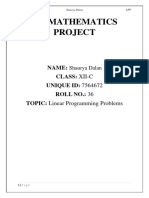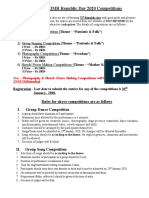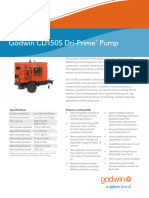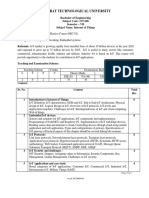BA Notes Chapter6
Uploaded by
Charanvenkatesh GBA Notes Chapter6
Uploaded by
Charanvenkatesh GBUILDING LINEAR OPTIMIZATION MODELS ON SPREADSHEETS,
SOLVING LINEAR OPTIMIZATION MODELS,
GRAPHICAL INTERPRETATION OF LINEAR OPTIMIZATION,
USING OPTIMIZATION MODELS OF PREDICTION AND INSIGHT,
TYPES OF CONSTRAINTS IN OPTIMIZATION MODELS,
PROCESS SELECTION MODELS,
BLENDING MODELS,
PORTFOLIO INVESTMENT MODELS
1. LINEAR OPTIMIZATION MODEL
Linear Optimization (Linear Programming)
Linear optimization, is also known as linear programming (LP), is a method used to achieve the best
outcome (such as maximum profit or lowest cost) in a mathematical model whose requirements are
represented by linear relationships. It involves maximizing or minimizing a linear objective function,
subject to a set of linear constraints.
Key Components:
1. Objective Function: This is the function that needs to be maximized or minimized.
2. Decision Variables: These represent the unknowns that affect the objective function.
3. Constraints: These are restrictions or limitations (expressed as linear inequalities or
equations) on the decision variables.
Example: Maximizing Profit
Let’s assume a company produces two types of products: Product A and Product B. The company
wants to determine how many units of each product to produce to maximize its profit.
Step 1: Define Variables
Let:
• x1: Number of units of Product A to produce
• x2: Number of units of Product B to produce
Step 2: Objective Function
The profit for each unit of Product A is $5, and the profit for each unit of Product B is $3. The
objective is to maximize the total profit, which is given by:
Maximize Z =5x1+3x2
Where Z is the total profit.
Ramaraju Poosapati Business Analytics For year 2024 1
Step 3: Constraints
Assume the following constraints:
1. Material Availability:
o Each unit of Product A requires 2 units of raw material.
o Each unit of Product B requires 1 unit of raw material.
o The company has a total of 100 units of raw material available.
This constraint can be written as:
2x1+x2 ≤ 100
2. Labor Availability:
o Each unit of Product A requires 3 hours of labor.
o Each unit of Product B requires 2 hours of labor.
o There are 120 labor hours available.
This constraint can be written as:
3x1+2x2≤120
Non-negativity Constraint: The number of units of Product A and Product B cannot be negative:
x1≥0, x2≥0
Step 4: Linear Programming Model
The full linear optimization problem is:
Maximize Z =5x1+3x2
Subject to:
2x1+x2 ≤ 100
3x1+2x2≤120
x1≥0, x2≥0
Ramaraju Poosapati Business Analytics For year 2024 2
The optimal solution is to produce:
• 40 units of Product A (x1=40)
• 0 units of Product B (x2=0)
This maximizes the profit, resulting in a total profit of $200.
2. BUILDING LINEAR OPTIMIZATION MODELS ON SPREADSHEETS,
Excel's Solver is a powerful tool used to solve optimization problems, such as linear programming
(LP). In linear optimization, the goal is to maximize or minimize a given objective function, subject to
constraints.
To use Solver for linear optimization, follow these steps:
1. Define Decision Variables: Input cells represent the decision variables (e.g., quantities of
products to produce).
2. Formulate the Objective Function: Create a formula to express the goal (e.g., maximize
profit or minimize cost) based on the decision variables.
3. Set Constraints: Define the limitations on resources (e.g., raw materials or labor), which are
expressed as inequalities in other cells.
4. Open Solver: Go to the Data tab, click Solver, and configure the parameters. Set the
objective to the cell containing the objective function, select maximize or minimize, and
specify the decision variable cells.
Ramaraju Poosapati Business Analytics For year 2024 3
5. Add Constraints: Use the Add button to specify resource constraints and non-negativity
constraints (ensuring decision variables are non-negative).
6. Select Simplex LP as the solving method for linear problems and click Solve.
Solver will calculate the optimal values for the decision variables, helping you find the best solution
while satisfying all constraints. It is widely used in business, finance, and operations research for
tasks like maximizing profit or minimizing cost.
3. Solving Linear Optimization Models
In linear optimization, the goal is to find values for the decision variables that either maximize or
minimize an objective function while satisfying all constraints. Any solution that adheres to the
constraints is considered a feasible solution. However, finding the best (or optimal solution) among
many feasible solutions can be complex, especially when there are numerous variables and
constraints.
A manual approach would involve adjusting the decision variables in a spreadsheet and checking if
they meet the constraints, but this method is time-consuming and unreliable for finding an optimal
solution. To guarantee an optimal solution, a systematic mathematical approach is required.
Fortunately, Excel provides a tool called Solver, which is designed to handle these optimization
problems. Solver allows users to set the objective function, define decision variables, and include
constraints. It then uses advanced algorithms to find the optimal solution.
The Premium Solver, developed by Frontline Systems, is an enhanced version of the standard Excel
Solver. It offers better performance, greater accuracy, and improved reporting. While the standard
Solver is sufficient for many optimization problems, the Premium Solver offers additional features
and is recommended for more complex models.
4. GRAPHICAL INTERPRETATION OF LINEAR OPTIMIZATION
Linear optimization (also known as linear programming) can be understood visually when dealing
with two decision variables. The graphical method is a useful approach to solving linear optimization
problems, especially when there are only two variables. Here’s a breakdown of the key elements
involved:
1. Feasible Region:
• The feasible region is the area on a graph where all the constraints of the problem overlap. It
represents all possible combinations of the decision variables that satisfy the constraints.
• Each constraint is plotted as a straight line, and the region that satisfies the constraint lies on
one side of the line.
• The feasible region is bounded by these constraint lines and is typically a polygon. The
solutions to the problem must lie within this region.
2. Objective Function:
Ramaraju Poosapati Business Analytics For year 2024 4
• The objective function is either maximized or minimized and is represented as a line that can
be moved across the graph.
• It is usually expressed in the form Z=c1x1+c2x2 , where Z is the value to optimize, and x1 and x2
are the decision variables.
• The goal is to find the point in the feasible region where the objective function achieves its
highest (or lowest) value.
5. USING OPTIMIZATION MODELS OF PREDICTION AND INSIGHT
Once the model is solved (e.g., using Solver), we get the optimal values of x1 and x2 that maximize
profit under the given constraints. However, the true value of this optimization model comes from
analyzing the impact of changes:
Scenario Analysis: (Refer Example discussed in Linear Optimization
What-If Questions on Resources:
Increase in Material Supply: If the company can acquire more raw material, how much would profit
increase? By adjusting the material constraint (e.g., from 100 to 110 units) and re-solving, managers
can see if the additional investment is worthwhile.
Increase in Labor Hours: If more labour hours become available, what would the impact be on
production and profit? By updating the labour constraint (e.g., from 120 to 140 hours), managers can
determine if hiring temporary workers would be beneficial.
Price Sensitivity Analysis:
If the profit per unit of Product A decreases from $5 to $4, how much does the total profit drop? This
type of analysis helps in strategic planning, especially when market conditions force a price change.
Ramaraju Poosapati Business Analytics For year 2024 5
Sensitivity Analysis
Tools like Solver's Sensitivity Report help identify:
• Binding Constraints: Constraints that limit the optimal solution. If the material constraint is
binding, increasing material availability could significantly improve profit.
• Shadow Prices: The value of obtaining one more unit of a resource. For example, if the
shadow price of raw material is $2, acquiring an extra unit could increase profit by $2.
This analysis allows managers to make data-driven decisions, prioritize resource allocation, and
explore strategic opportunities effectively.
6. TYPES OF CONSTRAINTS IN OPTIMIZATION MODELS
Types of Constraints in Optimization Models
Formulating optimization models can be complex, particularly when it comes to identifying the
appropriate constraints. Understanding the different types of constraints is crucial for effective model
building. Here are common categories of constraints:
1. Simple Bounds
These constraints restrict the value of a single variable.
Examples:
"No more than $10,000 may be invested in stock ABC," mathematically: ABC ≤ 10,000
"At least 350 units of product Y must be produced to meet customer commitments," mathematically:
Y ≥ 350
2. Limitations
o These constraints deal with the allocation of scarce resources, ensuring that resource
usage does not exceed availability.
o Examples:
▪ "The amount of material used in production cannot exceed inventory
available."
▪ "Minutes used in assembly cannot exceed the available labor hours."
▪ "The amount shipped from the Austin plant in July cannot exceed the plant’s
capacity."
3. Requirements
o These constraints specify minimum levels of performance or obligations that must
be met.
Ramaraju Poosapati Business Analytics For year 2024 6
o Examples:
▪ "Enough cash must be available in February to meet financial obligations."
▪ "Production must be sufficient to meet customer orders."
▪ "The marketing plan should ensure at least 400 customers are contacted
each month."
4. Proportional Relationships
o These constraints involve ratios or specific relationships between variables,
commonly seen in mixing or blending problems.
o Examples:
▪ "The amount invested in aggressive growth stocks cannot be more than
twice the amount invested in equity-income funds."
▪ "The octane rating of gasoline from mixing different crude blends must be at
least 89."
5. Balance Constraints
o These constraints ensure that input equals output, often used in flow or inventory
models to account for material or money movement.
o Examples:
▪ "Production in June plus any available inventory must equal June’s demand
plus inventory held to July."
▪ "The total amount shipped to a distribution center from all plants must
equal the amount shipped from the center to all customers."
▪ "The total amount of money invested or saved in March must equal the
amount available at the end of February."
7. PROCESS SELECTION MODELS,
Process selection models are used to make decisions about which process to choose for producing a
good. These models help organizations decide between different production options based on
factors like cost, efficiency, and resource availability. One common application of process selection
models is in make-or-buy decisions, where a company must determine whether to produce a
product internally or outsource it to an external supplier.
Ramaraju Poosapati Business Analytics For year 2024 7
Key Concepts
• Make-or-Buy Decision: A strategic choice between manufacturing a product in-house or
contracting the production to another company.
• Objective: The goal is usually to minimize cost or maximize profit while meeting production
requirements and adhering to resource limitations.
• Considerations: Factors such as production cost, capacity constraints, quality requirements,
and flexibility influence these decisions.
Example Scenario
Suppose a company needs to decide whether to manufacture a product in-house or outsource the
production. Here is a simplified illustration of how a process selection model could be formulated:
1. Define Decision Variables:
o x1: Number of units produced in-house.
o x2: Number of units subcontracted.
2. Objective Function:
o The objective might be to minimize the total cost of production, which includes the
cost of producing in-house and the cost of subcontracting.
Minimize Z=c1x1+c2x2
o Here, c1 is the cost per unit for in-house production, and c2 is the cost per unit for
outsourcing.
3. Constraints:
o Demand Constraint: Ensure total production meets the required demand.
x1+x2≥Demand
o Capacity Constraint: Limit the number of units that can be produced in-house based
on available resources. x1 ≤In-house Capacity
o Non-negativity Constraints: x1≥0, x2≥0
Insights from Process Selection Models
• Cost-Benefit Analysis: The model helps compare the costs of in-house production versus
outsourcing, guiding decisions based on financial outcomes.
• Resource Management: By incorporating capacity constraints, the model ensures that
resource limitations are considered in the decision-making process.
• Flexibility and Risk Management: Process selection models can also evaluate the trade-offs
between flexibility and risk, such as the reliability of suppliers and the impact on quality.
By using these models, companies can make informed decisions that optimize resource use and align
with strategic objectives.
Ramaraju Poosapati Business Analytics For year 2024 8
8. BLENDING MODELS
Blending Problems in Optimization Models
Blending problems are a common type of optimization model where several raw materials with
different characteristics are combined to produce a final product that meets specific requirements or
specifications. These problems are prevalent in industries such as dietary planning, gasoline and oil
refining, coal production, fertilizer manufacturing, and many other sectors that deal with bulk
commodities.
Key Concepts of Blending Problems
• Objective: The goal is often to minimize cost or maximize profit while satisfying the
constraints related to the properties or proportions of the raw materials.
• Proportional Constraints: These are a defining feature of blending problems and ensure that
the mixture meets desired specifications, such as nutritional content, quality standards, or
chemical composition.
Example of a Blending Problem
Scenario: Gasoline Production
A refinery needs to blend two types of crude oil to produce gasoline. The two types of crude oil have
different costs and properties:
• Crude Oil A: Cost per barrel is $50 and has an octane rating of 85.
• Crude Oil B: Cost per barrel is $70 and has an octane rating of 95.
• The final gasoline product must have an average octane rating of at least 89.
Formulating the Model
1. Decision Variables:
o x1: Number of barrels of Crude Oil A to use.
o x2: Number of barrels of Crude Oil B to use.
2. Objective Function:
o Minimize the total cost of the crude oil blend:
Minimize Z=50x1+70x2
3. Constraints:
o Octane Rating Constraint: The average octane rating must be at least 89.
o Simplifying this inequality yields: 85x1+95x2≥89 (x1+x2)
Ramaraju Poosapati Business Analytics For year 2024 9
o Demand Constraint: Ensure a certain amount of gasoline is produced, e.g., at least
1,000 barrels. x1+x2≥1,000
o Non-negativity Constraints: x1≥0, x2≥0
Insights from Blending Models
• Cost Efficiency: By finding the optimal mix of raw materials, companies can minimize
production costs while meeting product specifications.
• Quality Assurance: Proportional constraints ensure that the final product maintains the
required quality standards.
• Resource Utilization: These models help in the efficient use of available resources, balancing
cost and quality in production processes.
Blending problems demonstrate the practical use of linear programming in industries where the
composition of a product is crucial for cost-effectiveness and compliance with quality standards.
9. PORTFOLIO INVESTMENT MODELS
Financial investment problems, especially those related to portfolio management, are commonly
modelled and solved using linear optimization techniques. These portfolio investment models share
many characteristics with blending problems, as they involve selecting and allocating various assets
to achieve a specific financial goal while meeting a set of constraints.
Key Concepts in Portfolio Investment Models
• Objective: The primary goal is typically to maximize return or minimize risk while meeting
certain investment constraints.
• Decision Variables: Represent the amount of money to be invested in each asset or financial
instrument.
• Constraints: These can include budget limitations, risk exposure limits, or requirements for
diversification.
Characteristics of Portfolio Investment Models
1. Blending Nature: Similar to blending models in production, portfolio models involve
combining different financial assets, such as stocks, bonds, and mutual funds, in a way that
optimizes the overall performance of the investment portfolio.
2. Proportional Constraints: Often used to ensure that the proportions of various investments
meet specific criteria. For example, the percentage of total investment in high-risk assets
may need to be limited to manage risk.
Ramaraju Poosapati Business Analytics For year 2024 10
Example of a Portfolio Investment Problem
Scenario
An investor has $1,000,000 to allocate among three investment options:
• Stock A: Expected annual return of 8%
• Bond B: Expected annual return of 5%
• Mutual Fund C: Expected annual return of 6%
The investor wants to maximize the expected return while satisfying the following constraints:
1. No more than 50% of the total investment can be allocated to Stock A (to manage risk).
2. At least 20% of the total investment must be allocated to Bond B (for stability).
3. At least 30% of the total investment must be allocated to Mutual Fund C (for diversification).
Formulating the Model
1. Decision Variables:
o x1: Amount invested in Stock A
o x2: Amount invested in Bond B
o x3: Amount invested in Mutual Fund C
2. Objective Function:
Maximize the total expected return:
Maximize Z=0.08x1+0.05x2+0.06x3
3. Constraints:
o Total Investment Constraint: x1+x2+x3=1,000,000
o Risk Management Constraint (Stock A): x1≤0.5×1,000,000
o Stability Constraint (Bond B): x2≥0.2×1,000,000
o Diversification Constraint (Mutual Fund C): x3≥0.3×1,000,000
o Non-negativity Constraints: x1≥0,x2≥0,x3≥0
Insights from Portfolio Investment Models
• Risk Management: By setting constraints on the proportion of high-risk investments, the
model ensures a balanced and well-diversified portfolio.
• Return Optimization: The model helps determine the optimal allocation of funds to
maximize expected returns within the given risk and diversification parameters.
• Scenario Analysis: Investors can modify the constraints or expected returns to analyze the
impact of market changes or different investment strategies.
These models are powerful tools for financial planning and investment strategy, providing a
structured approach to achieving financial objectives while managing risk and ensuring
diversification.
Ramaraju Poosapati Business Analytics For year 2024 11
You might also like
- Hourglass Workout Program by Luisagiuliet 276% (21)Hourglass Workout Program by Luisagiuliet 251 pages
- The Hold Me Tight Workbook - Dr. Sue Johnson100% (16)The Hold Me Tight Workbook - Dr. Sue Johnson187 pages
- Read People Like A Book by Patrick King-Edited62% (65)Read People Like A Book by Patrick King-Edited12 pages
- Livingood, Blake - Livingood Daily Your 21-Day Guide To Experience Real Health77% (13)Livingood, Blake - Livingood Daily Your 21-Day Guide To Experience Real Health260 pages
- COSMIC CONSCIOUSNESS OF HUMANITY - PROBLEMS OF NEW COSMOGONY (V.P.Kaznacheev,. Л. V. Trofimov.)94% (212)COSMIC CONSCIOUSNESS OF HUMANITY - PROBLEMS OF NEW COSMOGONY (V.P.Kaznacheev,. Л. V. Trofimov.)212 pages
- Donald Trump & Jeffrey Epstein Rape Lawsuit and Affidavits83% (1016)Donald Trump & Jeffrey Epstein Rape Lawsuit and Affidavits13 pages
- The 36 Questions That Lead To Love - The New York Times94% (34)The 36 Questions That Lead To Love - The New York Times3 pages
- The 36 Questions That Lead To Love - The New York Times95% (21)The 36 Questions That Lead To Love - The New York Times3 pages
- Jeffrey Epstein39s Little Black Book Unredacted PDF75% (12)Jeffrey Epstein39s Little Black Book Unredacted PDF95 pages
- The 4 Hour Workweek, Expanded and Updated by Timothy Ferriss - Excerpt23% (954)The 4 Hour Workweek, Expanded and Updated by Timothy Ferriss - Excerpt38 pages
- Michael J. Folk, Bill Zoellick, Greg Riccardi - File Structures - An Object-Oriented Approach With C++-Addison-Wesley (1998)No ratings yetMichael J. Folk, Bill Zoellick, Greg Riccardi - File Structures - An Object-Oriented Approach With C++-Addison-Wesley (1998)749 pages
- Linear Programming Basic Concepts and Graphical SolutionsNo ratings yetLinear Programming Basic Concepts and Graphical Solutions7 pages
- Chapter 4 Linear Programming Problems - I 2023No ratings yetChapter 4 Linear Programming Problems - I 20237 pages
- 1.2 Linear Programming: Model Formulation and Graphical SolutionNo ratings yet1.2 Linear Programming: Model Formulation and Graphical Solution10 pages
- Unit Three Intro. to Linear Programming 1No ratings yetUnit Three Intro. to Linear Programming 118 pages
- Mathematical Formulation of Linear Programming ProblemsNo ratings yetMathematical Formulation of Linear Programming Problems5 pages
- Skills Framwork For The Information Age v6 PDFNo ratings yetSkills Framwork For The Information Age v6 PDF2 pages
- SYNC IEC60870-5 104 Slave Interface Usermanual Rev1.0.9No ratings yetSYNC IEC60870-5 104 Slave Interface Usermanual Rev1.0.924 pages
- Fibocom_FM350_AT Commands User Manual_V2.10No ratings yetFibocom_FM350_AT Commands User Manual_V2.10344 pages
- Columbia University Mention of Hedy LamarrNo ratings yetColumbia University Mention of Hedy Lamarr44 pages
- Submitted Proposal-DfT-QR To Connected Places Catapult Community PlatformNo ratings yetSubmitted Proposal-DfT-QR To Connected Places Catapult Community Platform27 pages
- INE's Implementing Nexus Bootcamp Lab Scenarios: Topology OverviewNo ratings yetINE's Implementing Nexus Bootcamp Lab Scenarios: Topology Overview18 pages
- Gujarat Technological University: Bachelor of EngineeringNo ratings yetGujarat Technological University: Bachelor of Engineering3 pages
- Pricing Strategies in Mobile Telecommunications MarketsNo ratings yetPricing Strategies in Mobile Telecommunications Markets13 pages
- Syllabus Database Management For Business Fall 2024-2025-1No ratings yetSyllabus Database Management For Business Fall 2024-2025-19 pages
- Livingood, Blake - Livingood Daily Your 21-Day Guide To Experience Real HealthLivingood, Blake - Livingood Daily Your 21-Day Guide To Experience Real Health
- COSMIC CONSCIOUSNESS OF HUMANITY - PROBLEMS OF NEW COSMOGONY (V.P.Kaznacheev,. Л. V. Trofimov.)COSMIC CONSCIOUSNESS OF HUMANITY - PROBLEMS OF NEW COSMOGONY (V.P.Kaznacheev,. Л. V. Trofimov.)
- Donald Trump & Jeffrey Epstein Rape Lawsuit and AffidavitsDonald Trump & Jeffrey Epstein Rape Lawsuit and Affidavits
- The 36 Questions That Lead To Love - The New York TimesThe 36 Questions That Lead To Love - The New York Times
- The 36 Questions That Lead To Love - The New York TimesThe 36 Questions That Lead To Love - The New York Times
- Jeffrey Epstein39s Little Black Book Unredacted PDFJeffrey Epstein39s Little Black Book Unredacted PDF
- The 4 Hour Workweek, Expanded and Updated by Timothy Ferriss - ExcerptThe 4 Hour Workweek, Expanded and Updated by Timothy Ferriss - Excerpt
- Michael J. Folk, Bill Zoellick, Greg Riccardi - File Structures - An Object-Oriented Approach With C++-Addison-Wesley (1998)Michael J. Folk, Bill Zoellick, Greg Riccardi - File Structures - An Object-Oriented Approach With C++-Addison-Wesley (1998)
- Linear Programming Basic Concepts and Graphical SolutionsLinear Programming Basic Concepts and Graphical Solutions
- 1.2 Linear Programming: Model Formulation and Graphical Solution1.2 Linear Programming: Model Formulation and Graphical Solution
- Mathematical Formulation of Linear Programming ProblemsMathematical Formulation of Linear Programming Problems
- Practice Problems in Statistics and Data ReductionFrom EverandPractice Problems in Statistics and Data Reduction
- SYNC IEC60870-5 104 Slave Interface Usermanual Rev1.0.9SYNC IEC60870-5 104 Slave Interface Usermanual Rev1.0.9
- Submitted Proposal-DfT-QR To Connected Places Catapult Community PlatformSubmitted Proposal-DfT-QR To Connected Places Catapult Community Platform
- INE's Implementing Nexus Bootcamp Lab Scenarios: Topology OverviewINE's Implementing Nexus Bootcamp Lab Scenarios: Topology Overview
- Gujarat Technological University: Bachelor of EngineeringGujarat Technological University: Bachelor of Engineering
- Pricing Strategies in Mobile Telecommunications MarketsPricing Strategies in Mobile Telecommunications Markets
- Syllabus Database Management For Business Fall 2024-2025-1Syllabus Database Management For Business Fall 2024-2025-1

































